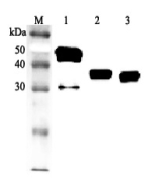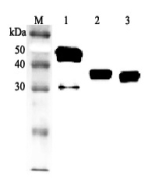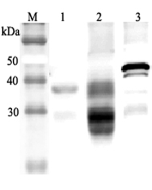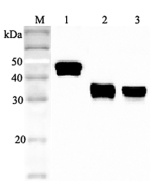Cookie Policy: This site uses cookies to improve your experience. You can find out more about our use of cookies in our Privacy Policy. By continuing to browse this site you agree to our use of cookies.
AdipoGen Life Sciences
Clusterin (secretory form) (human) (rec.)

| Product Details | |
|---|---|
| Synonyms | TRPM-2; Apolipoprotein J; APO-J; CLI; CLU; SGP-2 |
| Product Type | Protein |
| Properties | |
| Source/Host | HEK 293 cells |
| Sequence |
Signal peptide sequence and the human secretory clusterin (aa 1-449) are fused at the C-terminus to a FLAG®-tag. |
| Crossreactivity | Human |
| MW | 80kDa (under non-reducing conditions); 39kDa and 40kDa (under reducing conditions) (by SDS-PAGE). |
| Purity | ≥90% (SDS-PAGE) |
| Endotoxin Content | <0.01EU/μg purified protein (LAL test; Lonza). |
| Concentration |
After reconstitution: for 10µg size: 0.1mg/ml for 50µg size: 1mg/ml |
| Reconstitution |
10µg size: Reconstitute with 100µl sterile water. 50µg size: Reconstitute with 50µl sterile water. PBS containing at least 0.1% BSA should be used for further dilutions. |
| Formulation | Lyophilized. Contains PBS. |
| Other Product Data |
Uniprot link P10909: Clusterin (human) [Precursor] FLAG is a registered trademark of Sigma-Aldrich Co. |
| Shipping and Handling | |
| Shipping | BLUE ICE |
| Short Term Storage | +4°C |
| Long Term Storage | -20°C |
| Handling Advice |
After reconstitution, prepare aliquots and store at -20°C. Avoid freeze/thaw cycles. Centrifuge lyophilized vial before opening and reconstitution. PBS containing at least 0.1% BSA should be used for further dilutions. |
| Use/Stability |
Stable for at least 6 months after receipt when stored at -20°C. Working aliquots are stable for up to 3 months when stored at -20°C. |
| Documents | |
| MSDS |
 Download PDF Download PDF |
| Product Specification Sheet | |
| Datasheet |
 Download PDF Download PDF |
Clusterin shares homology with the small heat shock protein family of molecular chaperones. The mature secreted form of the protein is a glycosylated, 80kDa disulfide-linked heterodimer of α and β subunits (produced by internal cleavage). Clusterin is expressed in virtually all tissues and found in all human fluids. It is involved in numerous physiological processes important for carcinogenesis and tumor growth, including apoptotic cell death, cell cycle regulation, DNA repair, cell adhesion, tissue remodeling, lipid transportation, membrane recycling and immune system regulation. Clusterin also exists as a nuclear protein. The secreted form of Clusterin has extracellular chaperone and anti-apoptotic activities while the nuclear form acts as a proapoptotic factor.
- Clusterin induces matrix metalloproteinase-9 expression via ERK1/2 and PI3K/Akt/NF-κB pathways in monocytes/macrophages: Y.-J. Shim, et al.; J. Leuk. Biol. 90, 761 (2011)
- Clusterin and LRP2 are critical components of the hypothalamic feeding regulatory pathway: S.Y. Gil, et al.; Nat. Commun. 4, 1862 (2013)
- Clusterin/ApoJ enhances central leptin signaling through Lrp2-mediated endocytosis: K. Byun, et al.; EMBO Rep. 15, 801 (2014)










